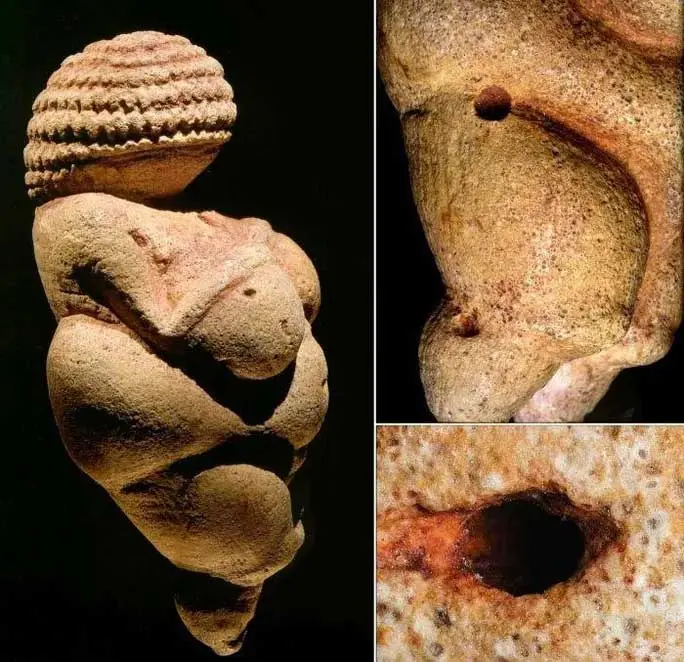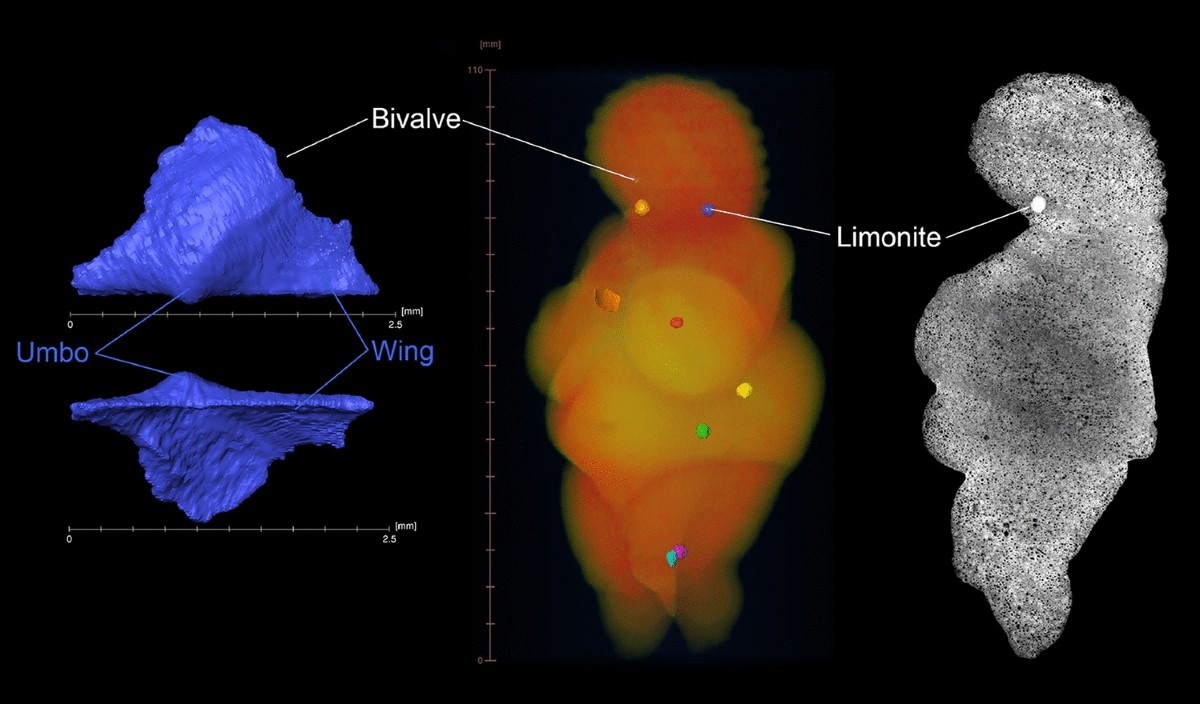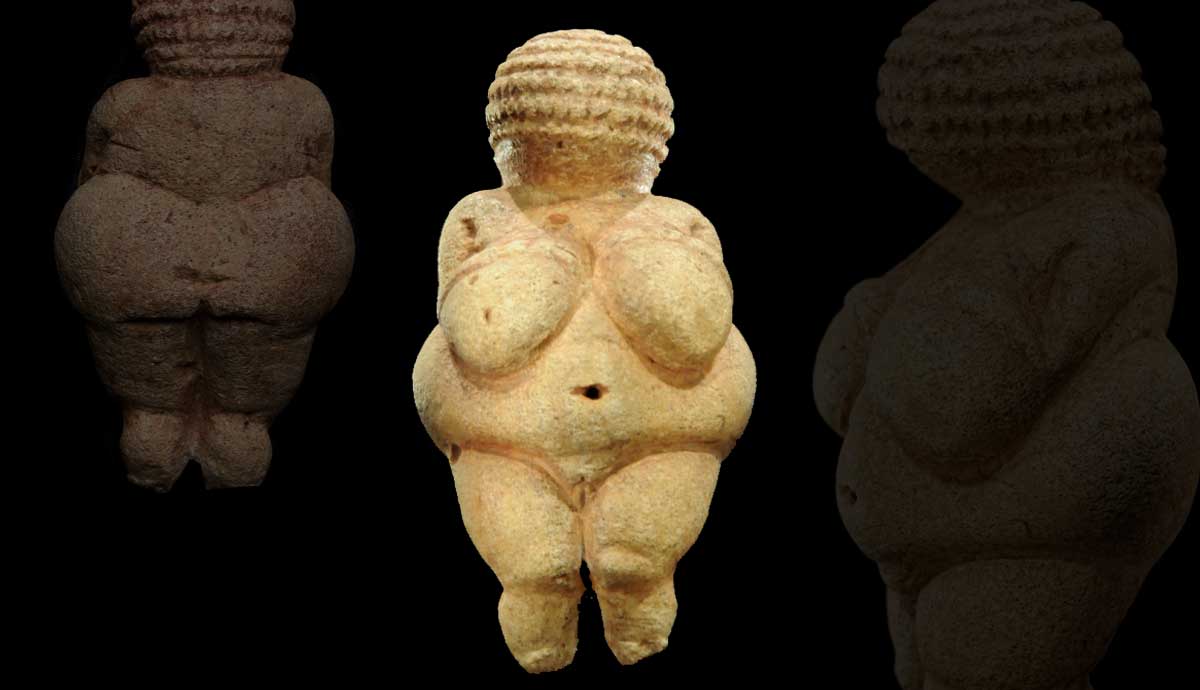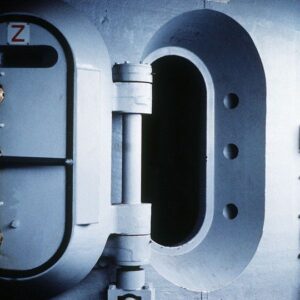The Willendorf Venus: A 30,000-Year-Old Masterpiece Reveals Astonishing Secrets

The “Willendorf Venus” stands as one of the most revered archaeological treasures from the Upper Paleolithic era. Discovered in 1908 by scientist Johann Veran near Willendorf, Austria, this small yet profound statue has captivated the scientific community for over a century. Recently, groundbreaking research using micro-CT scanning technology has unveiled astonishing secrets hidden within this ancient artifact, offering new insights into its origins and immense value.
A Symbol of Fertility and Procreation

The Venus of Willendorf, measuring just 11 centimeters in length, is carved from a sedimentary limestone known as oolite and painted with red ochre. The statue portrays a naked woman with exaggerated features, prominently emphasizing the breasts, genitalia, buttocks, and legs. Despite the detailed depiction of her hairstyle or headgear, the statue notably lacks facial features. For decades, this figure has been regarded as a symbol of fertility and procreation, reflecting the cultural beliefs of Paleolithic societies.
Historical Estimations and the Artifact’s Age

In the 1970s, researchers initially estimated the statue’s age to be around 20,000 years. However, further analysis conducted in the 1990s pushed this date back to between 25,000 and 30,000 BCE, underscoring the artifact’s remarkable age and historical significance. The “Willendorf Venus” not only serves as a symbol of prehistoric art but also as a valuable window into the distant past.
Revelations from Micro-CT Scanning

The recent application of micro-CT scanning technology has brought forth surprising new details about the statue. A research team led by anthropologist Gerhard Weber from the University of Vienna discovered that the internal structure of the oolite is heterogeneous, containing multiple layers of sediment with particles of varying density and size. Most notably, small fragments of limonite, an impurity within the statue, were identified—an impurity that could not have originated from the region around Willendorf.
Tracing the Statue’s Origins

By comparing data from Jurassic-era rocks, scientists determined that the oolite used to carve the “Willendorf Venus” originated from the Lake Garda region in northern Italy. This revelation suggests that the statue, or at least the stone from which it was crafted, journeyed a significant distance from south to north across the Alps. The distance, potentially as far as 730 kilometers, underscores the remarkable journey the statue undertook.
The Sacredness and Cultural Significance of the “Willendorf Venus”

The extraordinary care taken to transport and protect the “Willendorf Venus” suggests it held immense significance in the beliefs or culture of its time. The arduous journey across treacherous landscapes highlights the statue’s sacredness and value. Thanks to modern micro-CT scanning technology, the secrets of the “Willendorf Venus” have been brought to light, providing a deeper understanding of its origins and cultural importance.
Conclusion
With a history stretching over 30,000 years and a journey spanning hundreds of kilometers from northern Italy to Austria, the “Willendorf Venus” is more than just a symbol of the Upper Paleolithic era. It is a testament to the craftsmanship, beliefs, and cultural practices of ancient humans. The latest research, published in Scientific Reports, cements the “Willendorf Venus” as an invaluable piece of our shared cultural heritage, offering profound insights into the lives and beliefs of our distant ancestors.
Video
News
The Hanging Temple: China’s 1,500-Year-Old Cliffside Marvel of Faith and Engineering
The Hanging Temple: China’s 1,500-Year-Old Cliffside Marvel of Faith and Engineering Perched precariously on the cliffs of Mount Heng in Shanxi Province, China, the Hanging Temple, also known as Xuankong Temple, Hengshan Hanging Temple, or Hanging Monastery, is an architectural…
Unveiling the Maya: Hallucinogens and Rituals Beneath the Yucatán Ball Courts
Unveiling the Maya: Hallucinogens and Rituals Beneath the Yucatán Ball Courts New archaeological research has uncovered intriguing insights into the ritual practices of the ancient Maya civilization. The focus of this study is a ceremonial offering found beneath the sediment…
Uncovering the Oldest Agricultural Machine: The Threshing Sledge’s Neolithic Origins
Uncovering the Oldest Agricultural Machine: The Threshing Sledge’s Neolithic Origins The history of agricultural innovation is a fascinating journey that spans thousands of years, and one of the earliest known agricultural machines is the threshing sledge. Recently, a groundbreaking study…
Nara’s Ancient Sword: A 1,600-Year-Old Protector Against Evil Spirits
Nara’s Ancient Sword: A 1,600-Year-Old Protector Against Evil Spirits In a remarkable discovery that has captured the attention of archaeologists and historians alike, a 7.5-foot-long iron sword was unearthed from a 1,600-year-old burial mound in Nara, Japan. This oversized weapon,…
The Inflatable Plane, Dropped Behind the Lines for Downed Pilots
Experimental The Inflatable Plane, Dropped Behind the Lines for Downed Pilots The Inflatoplane from Goodyear was an unconventional aircraft developed by the Goodyear Aircraft Company, a branch of the renowned Goodyear Tire and Rubber Company, also famed for the Goodyear…
USS New Jersey – Black Dragon
Battleships, Latest USS New Jersey – Black Dragon The USS New Jersey (BB-62) is an Iowa-class battleship that has seen combat in World War II, the Korean War, the Vietnam War, and the Lebanese Civil War, making her one of the…
End of content
No more pages to load











